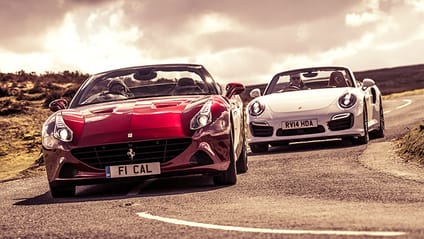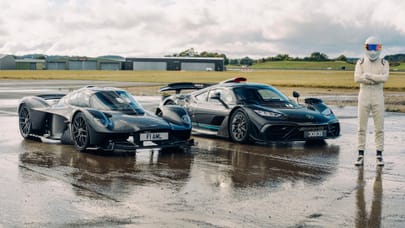
Ferrari California T vs Porsche 911 Turbo
Two £150,000 super cabrios from Stuttgart and Maranello. Tested in, um, Devon. Time for a one-on-one


We were expecting a sunset, one of those soft, ripe ones, all satsuma sun and peach-skin sky. It's why we made such haste across Exmoor, why we didn't allow the salty tang of Braunton's fish and chip shops to divert us, why we risked the tricky slipway down onto the beach at Saunton Sands. It had been a fresh, fragrantly beautiful day up on the moors, perfect weather for convertibles, and we were full of hope that we'd be able to watch God's bright orange ping-pong ball bob about on a fiery sea, the perfect backdrop for our two seductively potent sports cars.
Pictures: Mark FagelsonThis feature was originally published in the June 2015 issue of Top Gear magazine
Advertisement - Page continues below
Of course, as soon as twin-turbo engines got a scent of sea air, the cloud rolled in. Not the fluffy-bunny stuff, but the flat high-level kind that sucks out all the colour and warmth. It was like a Dementor had flown over Devon, and only Mark's special camera filter could dispel the gloom. The Ferrari's paintwork lost its ping, fading to murky brown; the Porsche looked like a 911-shaped fog patch. These are cars for beach-front living. Ideally the Costa Brava or Côte d'Azur, somewhere with cocktail bars and hip clubs rather than tea rooms and dog walkers, but if any car can bring a zingy slice of Mediterranean glamour to bus-tour Britain, it's one that wears a Prancing Horse.

This is the new California T, a thoroughly re-engineered take on the old one, although the basic format, layout and design remains the same: four seats inside, folding hard-top, front engine, rear-wheel drive, seven-speed double-clutch gearbox linking those fore and aft components.
Advertisement - Page continues below
It's the engine that's got everyone talking, a 3.9-litre twin-turbocharged V8, Ferrari's first turbo motor since the F40. But this time it's not been done for power and excitement reasons, more because that's what legislation demands. And, yes, it uses 15 per cent less fuel (although don't for a moment believe the 24mpg claim - we got 18.5mpg on the 200-mile motorway haul down from London, a scant 12.4 on the tight stuff). But - and this is important, because it's easily overlooked when you take in the boulevard lines - it's also a proper turbo nut job. It is, in fact, as fast as the old F40. Almost precisely: both do 0-124mph in 11-point-something seconds.

Four-wheel-drive traction enables this bonkers 911 to snatch itself off the line even faster, but once moving, there's barely a fag paper in it for pace. So, the 911. It's a Turbo S Cabrio with PDK gearbox. In white. With a red leather interior. It is everything that 911 purists hate about 911s: the laggy engine response, the muted noise, the corrupted steering, the wobbly chassis, the silly money. It's so reviled it's practically a Panamera.

I don't disagree with any of that. There is a bit of structural shake - more than in the Ferrari, certainly - the steering doesn't dance like a RWD-only car's, the engine does take a moment to pick itself up, and blows so riotously hard through the mid-range that you never need to go beyond 5,000rpm, or have the brain space to think about the sound it's emitting. Oh, and have you heard the one about Porsche charging £150,000 for an option-less 911? Not a joke, sadly.

But here's the thing. The 911 operates at a very high level indeed. Ridiculously high. So even if you chuck in a few dynamic issues, a high price and an, ahem, curious spec, you're still left with a fearsomely desirable car. The perfect foil to the Ferrari, in fact, given their identical power outputs and that both tread a line that encompasses both roof-down flounce and black-top attack.
Advertisement - Page continues below
We're parked up on the beach, greyness has arrived and while Mark rifles through his bags for the Insta-Sunshine filter, we've got the opportunity to kick the tyres. The Porsche is a remarkable piece of packaging. Look how small its rear end is compared with the Ferrari's, then realise that engine, gearbox, driven axle and roof mechanism are all packaged in there. It's shorter, narrower and lower, but somehow crafts way more space for those confined to the back seats. You sit low, the cabin is unfussy, it hits all the ergonomic metrics and makes you want to drive - if only to avoid having to look at the leather for a moment longer.

Nothing smells like a Ferrari. Even with the roof down, the pungent whiff of pampered cow hide gives the California a richness, a luxury, that's quite beyond the 911. You can also see it in the depth of the paint, the beautifully rendered badge, even the elegant, symmetrical installation of the engine. Think what you like about the way the Ferrari looks, but the detail, the finish, is sublime.
Advertisement - Page continues below
Apart from the wind deflector. Clearly this slipped through the quality-control net. In the Porsche, you press a button and it emerges from the rear bulkhead in a way that makes you marvel at the rigour of German engineering, but the Ferrari's requires assembly. Four pieces of plastic that have to be puzzled over, clipped together, the whole then slotted into place. It's a pointless faff, and anyway cabin turbulence isn't that bad with the roof down.

You sit higher in the Ferrari, the driving position more GT-ish by dint of the front engine. You've got a lot of car ahead of you, the A-pillars are thick and wide and the hardcore mount-everything-on-the-steering-wheel approach jars a little. We also have Apple's CarPlay system. This barely has any more functionality than a standard USB plug-in that you run through your infotainment screen. Apple's maps are better than Ferrari's, and it can read out your text messages. For this, Ferrari sees fit to charge £2,400. But then this is the firm that charges £7,104 for the Rosso California paint and £4,032 for front and rear parking cameras, so you pays your money...

There's a new dial between the air vents that has a touch-sensitive ring allowing you to cycle through a whole load of turbo info, from available response to boost pressure. It's a gimmick, but one that makes clear Ferrari isn't ashamed it's gone down the turbo route.

It's not ashamed, because it's done a tremendous job. This is the right car to start with, of course, a car where the demands and expectations are lower than in, say, the 488 GTB, but all the same, it's a peachy motor. Ferrari has realised that you don't need to let the turbos give maximum blow as early as possible, that it's good to give drivers a reason to hold on for high revs. The Cali is torque-limited in every gear bar seventh, the engineers have played with the delivery, tinkered with the torque, and the car is more exciting as a result. Ferrari is good at engines, and this is a good Ferrari engine.

There's less inertia than in the 911, it's faster-revving, cleaner-breathing, better-sounding, more exciting. It's behaviour is more natural than forced induction, the turbos not allowed to play too much of a role. Earlier, pointing towards the west as the sun fell through the sky, prow framing Exmoor, the V8 was majestic, roiling and wailing across the landscape. It felt good. Bet I looked a right cock.

The Porsche is more guttural, the flat-six leaning more heavily on the turbos for assistance, but turn everything up to max, engage Sport Plus and it's a total weapon. Where the Ferrari is content to be coy, to tease a little, the Porsche just wallops right in with... TURBO. It's exciting alright, a proper unsubtle, gale-force blaze of power and acceleration, but it's too dominant, more difficult to meter out precisely, whacking great dollops of thrust available anywhere across the rev range.

But the Porsche's chassis? Well, that's a different matter. You sit low, making you more aware of the 911's low centre of gravity. It keys you into the road and never tries to distance you from mechanical goings-on. It's earthy and connected.

The Ferrari meanwhile has light, sharp steering; light, sharp brakes; and a light, sharp throttle. It's too much - the responses feel false, forced, distancing you from the actual sensations. As a result, the way it gets itself along B-roads is effortless, it gathers speed, sweeps round corners, consumes roads - but you don't find yourself engaged in proceedings. Instead, you look down and are always, always shocked by how fast you're travelling. The Ferrari is intent on doing the job for you, but making the responses sharp in an attempt to convince you that you're doing the work. It feels what it is: slightly artificial.

Where the Cali seems to say "Sit back, let me show you how we do this", the 911 is more "Want to go faster? We can go faster. We can always go faster." It wants to charge, but leaves the decision with you. That's part of Porsche's genetic make-up. The genius of the 911 is that it incorporates this with low-speed manners and long-range comfort. Yes, tyre noise is rowdier than it should be, the short-travel suspension is abrupt in comparison with the Cali's, and I reckon the low-slung cockpit is more of a hassle for those in the target age group, but it never fidgets or fights, and any scuttle shake is contained in an instant. Traction? Grip? Both stellar. The balance in the chassis, the steering, the oneness of it all, is something the Ferrari can't emulate.

For two days solid, I found myself getting out of the Ferrari nodding in appreciation, admiring the achievement, adoring the engine, but only one handling aspect - the faintly ridiculous turn-in grip - actually stuck with me. It's a majestic, aloof car. The ride may be a little brittle, but by and large it succeeds at its principal aim; to tackle every road with style and panache. But the California is so intent on looking good, it forgets about the driver.

The Porsche never does. That should be enough to earn it an easy victory here - and it does win, it is the one I'd have, it's way, way better than the purists give it credit for. But I have to admit a £150k 911 is not the sweet spot of the range (see page 80 for the answer to that), despite the power, speed, physicality and sheer togetherness of the whole package.

The Ferrari has the greater sense of occasion. If you're the type of person who likes driving with one arm resting on the door top, you'll be happier here, and although massively expensive when optioned up, £150k here feels like money more sensibly deployed. It is a very, very good car, the California, exactly the car it needs to be to appeal to its audience, I suspect (in fact, I'd argue that in this market sector, Ferrari knows its buyer better than Porsche). Trouble is, that's an audience you're more likely to find on the Côte d'Azur than in deepest Devon.
Trending this week
- Car Review
BMW iX3







